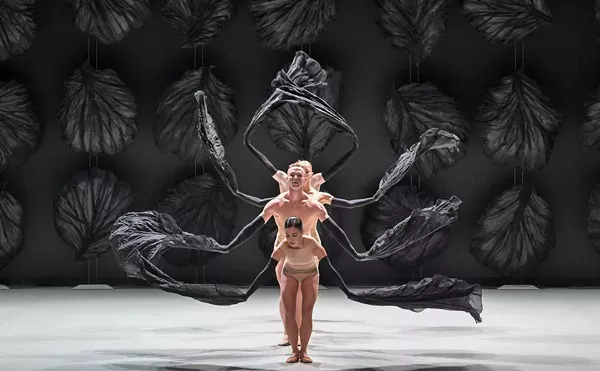
Audio By Carbonatix
[
{
"name": "GPT - Leaderboard - Inline - Content",
"component": "35519556",
"insertPoint": "5th",
"startingPoint": "3",
"requiredCountToDisplay": "3",
"maxInsertions": 100,
"adList": [
{
"adPreset": "LeaderboardInline"
}
]
}
]
We enter the Whitney Museum offices and introduce ourselves.
"I’m Steve Yzerman and this is Chris Osgood. We’re on assignment for the Metro Times. We need press passes."
The rep is a model of ideal female beauty. She’s afraid we’ll pee on her pedestal while howling. She puts a low-grade press kit into our paws. No color photographs. No meal ticket. No business cards from curators. It reminds us that we’re more fans than players in the Big Apple.
Ferretti and I have been diverted from the beer lines at Joe Louis to see the Whitney Biennial in New York City. This is the arena for contemporary American art. How to follow the game?
"Art is sporty in its own way," Ferretti says. "It’s as mean and shifty and opportunistic as hockey. It has skilled players and goons. There’s one problem. Unlike hockey, art has no rules."
What the puck?
We charge out into the arctic environment of the museum. White and icy and austere. We skate through the exhibit. I get no opposition but my own lack of understanding.
"Good," Ferretti says. "Now see if that ignorance shadows you like an opposing player assigned to Yzerman in the playoffs. It should follow you into corners and clutch and grab and hack and yap."
"I’ve got to fight through it?"
"If you want to score an insight. The opposing goalie is preconception itself. It’s padded with prejudice that may be reasonable around the neck and groin. But you can beat it if you’re deft enough. It takes skill and heart and aim. You want to put the puck in the net of universal human understanding that’s stitched with individual threads of sex and race and class and striving."
"Huh?"
Net of creation
I’m looking at a painting by Kurt Kauper titled "Diva Fiction No. 8." It’s a portrait of a red-robed woman in her early 30s. She’s in full sexual and social bloom. Graceful. Greedy. Gorgeous. Kauper makes his point about the flower of American industry in one cool stroke. I shake my head.
"What’s wrong?" Ferretti asks.
"I’ve got one rule in the otherwise lawless realm of art," I say. "If the clothes are on it’s a bad painting; if the clothes are off it’s a masterpiece."
Ferretti wants to slap a censored sticker across my mouth. I escape toward an uncut sheet of dollars. It’s as if they just rolled off the press at the mint. There’s activity underneath the glass. I see that the dollars are printed on Styrofoam that serves as earth for an ant farm.
The insects have adapted. This piece is an up-to-date statement about mindless work in an artificial environment. It also says a lot about decomposition under the face of the American dollar. The artist’s name is Yukinori Yanagi. I shake my head.
"What’s wrong?" Ferretti asks.
"I’ve got a second rule in the lawless realm of art," I say. "If the artist looks like me, then I identify as a human being with his success. If there’s no resemblance, then I’m jealous. Bitter. Alienated."
"Why do you insist upon being a goon?" Ferretti replies. "You’re not here to pummel art. You’re here to tally insights. Consider yourself both blocker and shooter in front of every artwork. What’s dreadful skates out of the crease to challenge you. Take your shot at understanding, through the opening the artist maneuvers you into seeing. A bad artist makes your inner goalie look like an impregnable monster. A good artist reveals your inner goalie’s weakness."
"I never thought of the museum as an arena for duels. Is this what you learned in art school?"
"This is what I learned after getting expelled from art school."
We’re in front a piece by Joseph Grigely. It consists of a rectangular patchwork of notes and letters. The papers are of various sizes, shapes, colors and textures. It’s something any pack rat could create from personal archives. It’s minor-league scrap. I’m so unimpressed that my inner goalie yawns in front of the artwork like a bored thug.
But then Ferretti passes me critical information. He puts it softly on my stick.
"The artist is deaf," he whispers. Suddenly, I’m looking for dialect in handwriting and I’m listening for scrawls in speech. I’ve scored an insight into the net of human understanding. It’s stitched to the web of creation. I see interconnecting languages of space and time and fashion and tool and scar.
Every person is a sentence unfolding. Or maybe every person is serving a sentence. In any case, we’re all woven into the same epic fabric. I shake my head.
"What’s wrong?" Ferretti asks.
"It took a deaf guy to get me thinking across dimensions. He does it for survival while I do it for sport. That makes him more sound."
The final score
The Whitney Biennial has been a tie. The curators brought in players from all over the country. They’ve built a team with defense in mind: No mistakes. It’s cost them offensive excitement.
It’s not that I want to be offended. It’s just that I need something more American than a politically correct representation of age and sex and race and locale. I need a reckless superstar. A bad boy. A maverick.
But maybe I’m considering art in my own overly regimented way. Ferretti’s hockey model for viewing art is sporting: Contentious and caged and exhausting.
It may be time to exit the rink of my brain. I’m ready to see art in a postgame state of reverie. As if I were relaxing at a topless bar on Eight Mile or Michigan Avenue.
We’re standing if front of an installation by Sarah Sze. It’s a swirling double helix in front of a window. Bright aluminum ladders twist like creative whimsy itself. Their steps lead into space, decorated with feminine knickknacks. The piece is high-horsepower, florid and elusive. It’s like looking at the ecstatic unraveling of a grunge ballerina’s spirit.
"What’s wrong?" Ferretti asks.
"Some art is naked to a fault," I say. "Other art bares all without losing mystique. The more that’s revealed, the more there is to see. A man falls deep in love."
Ferretti’s searching Sze’s work for a garter in which to place a dollar.
Meanwhile, I continue my search for the great American piece of art: Raw and elegant and iconoclastic and, most of all, bigger than life.
I’m an average white guy who needs to identify with heroic stuff. Funny that my needs are satisfied by a black woman. Or maybe it’s sad that I should think it so. In any case, Chakaia Booker’s work massages my crotch where the legs of past and future intersect. My masculinity hangs on a conservative old hinge. But there are times when it’s oiled liberally to great rejuvenative effect, so that my prick-nature rises to break the plane of suspicion in a moment of virile glory.
For this, I’ll take any catalyst. As long as it’s first rate.
"What’s wrong?" Ferretti asks.
Finally, I’m speechless. I’m no longer walled in a museum. I’m looking at Booker’s framed field of tires as if it were both a window to infinity and the mortal fabric of her womb. She’s woven discarded black rubber into a patch of cosmic ocean that’s tempestuous and placid and uncertain and alive. Her surface rhythms are natural. Dispassionate and wise. She’s exhibiting the hardest-earned maturity and eccentricity, too.
"Ferretti," I say, "Only the best artist can make her private parts universal."
We’ve got two models for seeing in the lawless realm of art. The hockey model. The strip-bar model. Can they be used simultaneously?
Ferretti’s not around to ask. He’s gone to see video and computer art.
I look again at Booker’s tapestry of tires. I wind up to shoot a puck of insight into her womanly net. But something else leaves my stick. I shoot a seed of understanding instead.
E-mail comments to letters@metrotimes.com




